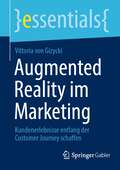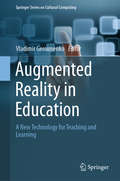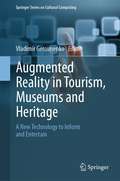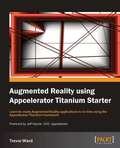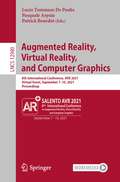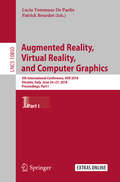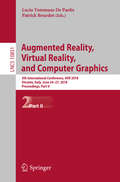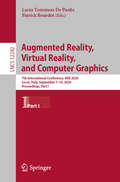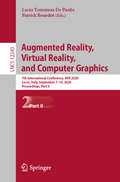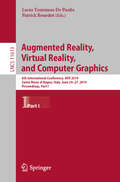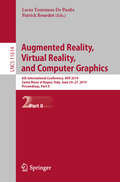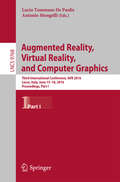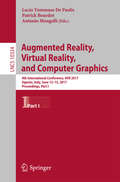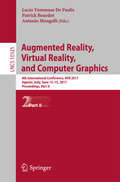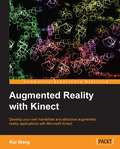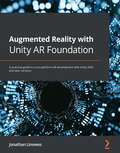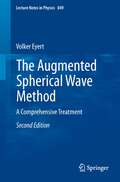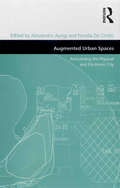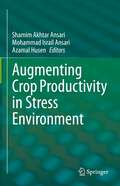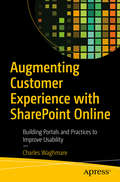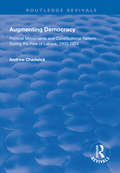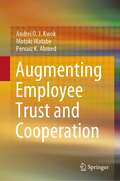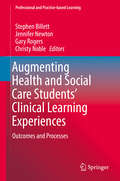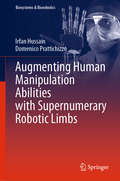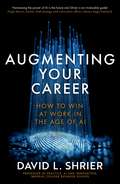- Table View
- List View
Augmented Reality im Marketing: Kundenerlebnisse entlang der Customer Journey schaffen (essentials)
by Vittoria von GizyckiDie Einsatzmöglichkeiten von Augmented Reality – der Erweiterung der Realität durch digitale Elemente – im E-Commerce sind vielfältig,. Der Verlauf der Customer Journey bietet eine sinnvolle Struktur, um eine systematische Einordnung verschiedener Augmented-Reality-Anwendungen aufzuzeigen. So wird anhand von zahlreichen Beispielen deutlich, dass die Möglichkeiten dieser Technologie noch bei Weitem nicht ausgeschöpft sind und für zahlreiche Unternehmen großes Potenzial bergen.
Augmented Reality in Education: A New Technology for Teaching and Learning (Springer Series on Cultural Computing)
by Vladimir GeroimenkoThis is the first comprehensive research monograph devoted to the use of augmented reality in education. It is written by a team of 58 world-leading researchers, practitioners and artists from 15 countries, pioneering in employing augmented reality as a new teaching and learning technology and tool. The authors explore the state of the art in educational augmented reality and its usage in a large variety of particular areas, such as medical education and training, English language education, chemistry learning, environmental and special education, dental training, mining engineering teaching, historical and fine art education. Augmented Reality in Education: A New Technology for Teaching and Learning is essential reading not only for educators of all types and levels, educational researchers and technology developers, but also for students (both graduates and undergraduates) and anyone who is interested in the educational use of emerging augmented reality technology.
Augmented Reality in Tourism, Museums and Heritage: A New Technology to Inform and Entertain (Springer Series on Cultural Computing)
by Vladimir GeroimenkoThis book provides extensive research into the use of augmented reality in the three interconnected and overlapping fields of the tourism industry, museum exhibitions, and cultural heritage. It is written by a virtual team of 50 leading researchers and practitioners from 16 countries around the world. The authors explore the opportunities and challenges of augmented reality applications, their current status and future trends, informal learning and heritage preservation, mixed reality environments and immersive installations, cultural heritage education and tourism promotion, visitors with special needs, and emerging post-COVID-19 museums and heritage sites. Augmented Reality in Tourism, Museums and Heritage: A New Technology to Inform and Entertain is essential reading not only for researchers, application developers, educators, museum curators, tourism and cultural heritage promoters, but also for students (both graduates and undergraduates) and anyone who is interested in the efficient and practical use of augmented reality technology.
Augmented Reality using Appcelerator Titanium Starter
by Trevor WardGet to grips with a new technology, understand what it is and what it can do for you, and then get to work with the most important features and tasks. It's a quick start tutorial to help you get started with creating Augmented Reality applications and acquainting yourself with essential aspects of creating AR applications using the Appcelerator Titanium Framework. The instructions are clear with easy to follow examples. This book is for anybody who wishes to understand how to build an Augmented Reality Application. It uses the Appcelerator Titanium mobile development framework, but the techniques and practices can be applied to other frameworks and native code. You will need to have a good working knowledge of development and JavaScript, it is not aimed at the beginner.
Augmented Reality, Virtual Reality, and Computer Graphics: 8th International Conference, AVR 2021, Virtual Event, September 7–10, 2021, Proceedings (Lecture Notes in Computer Science #12980)
by Lucio Tommaso De Paolis Pasquale Arpaia Patrick BourdotThis book constitutes the refereed proceedings of the 8th International Conference on Augmented Reality, Virtual Reality, and Computer Graphics, AVR 2021, held in Italy, in September 2021. Due to COVID-19 pandemic the conference was held virtually. The 38 full and 14 short papers were carefully reviewed and selected from 69 submissions. The papers discuss key issues, approaches, ideas, open problems, innovative applications and trends in virtual reality, augmented reality, mixed reality, applications in cultural heritage, in medicine, in education, and in industry.
Augmented Reality, Virtual Reality, and Computer Graphics: 5th International Conference, AVR 2018, Otranto, Italy, June 24–27, 2018, Proceedings, Part I (Lecture Notes in Computer Science #10850)
by Lucio Tommaso De Paolis Patrick BourdotThe 2-volume set LNCS 10850 and 10851 constitutes the refereed proceedings of the 5th International Conference on Augmented Reality, Virtual Reality, and Computer Graphics, AVR 2018, held in Otranto, Italy, in June 2018. The 67 full papers and 26 short papers presented were carefully reviewed and selected from numerous submissions. The papers are organized in the following topical sections: virtual reality; augmented and mixed reality; computer graphics; human-computer interaction; applications of VR/AR in medicine; and applications of VR/AR in cultural heritage; and applications of VR/AR in industry.
Augmented Reality, Virtual Reality, and Computer Graphics: 5th International Conference, AVR 2018, Otranto, Italy, June 24–27, 2018, Proceedings, Part II (Lecture Notes in Computer Science #10851)
by Lucio Tommaso De Paolis Patrick BourdotThe 2-volume set LNCS 10850 and 10851 constitutes the refereed proceedings of the 5th International Conference on Augmented Reality, Virtual Reality, and Computer Graphics, AVR 2018, held in Otranto, Italy, in June 2018. The 67 full papers and 26 short papers presented were carefully reviewed and selected from numerous submissions. The papers are organized in the following topical sections: virtual reality; augmented and mixed reality; computer graphics; human-computer interaction; applications of VR/AR in medicine; and applications of VR/AR in cultural heritage; and applications of VR/AR in industry.
Augmented Reality, Virtual Reality, and Computer Graphics: 7th International Conference, AVR 2020, Lecce, Italy, September 7–10, 2020, Proceedings, Part I (Lecture Notes in Computer Science #12242)
by Lucio Tommaso De Paolis Patrick BourdotThe 2-volume set LNCS 12242 and 12243 constitutes the refereed proceedings of the 7th International Conference on Augmented Reality, Virtual Reality, and Computer Graphics, AVR 2020, held in Lecce, Italy, in September 2020.* The 45 full papers and 14 short papers presented were carefully reviewed and selected from 99 submissions. The papers discuss key issues, approaches, ideas, open problems, innovative applications and trends in virtual reality, augmented reality, mixed reality, 3D reconstruction visualization, and applications in the areas of cultural heritage, medicine, education, and industry. * The conference was held virtually due to the COVID-19 pandemic.
Augmented Reality, Virtual Reality, and Computer Graphics: 7th International Conference, AVR 2020, Lecce, Italy, September 7–10, 2020, Proceedings, Part II (Lecture Notes in Computer Science #12243)
by Lucio Tommaso De Paolis Patrick BourdotThe 2-volume set LNCS 12242 and 12243 constitutes the refereed proceedings of the 7th International Conference on Augmented Reality, Virtual Reality, and Computer Graphics, AVR 2020, held in Lecce, Italy, in September 2020.*The 45 full papers and 14 short papers presented were carefully reviewed and selected from 99 submissions. The papers discuss key issues, approaches, ideas, open problems, innovative applications and trends in virtual reality, augmented reality, mixed reality, 3D reconstruction visualization, and applications in the areas of cultural heritage, medicine, education, and industry. * The conference was held virtually due to the COVID-19 pandemic.
Augmented Reality, Virtual Reality, and Computer Graphics: 6th International Conference, AVR 2019, Santa Maria al Bagno, Italy, June 24–27, 2019, Proceedings, Part I (Lecture Notes in Computer Science #11613)
by Lucio Tommaso De Paolis Patrick BourdotThe 2-volume set LNCS 11613 and 11614 constitutes the refereed proceedings of the 6th International Conference on Augmented Reality, Virtual Reality, and Computer Graphics, AVR 2019, held in Santa Maria al Bagno, Italy, in June 2019.The 32 full papers and 35 short papers presented were carefully reviewed and selected from numerous submissions. The papers discuss key issues, approaches, ideas, open problems, innovative applications and trends in virtual and augmented reality, 3D visualization and computer graphics in the areas of medicine, cultural heritage, arts, education, entertainment, military and industrial applications. They are organized in the following topical sections: virtual reality; medicine; augmented reality; cultural heritage; education; and industry.
Augmented Reality, Virtual Reality, and Computer Graphics: 6th International Conference, AVR 2019, Santa Maria al Bagno, Italy, June 24–27, 2019, Proceedings, Part II (Lecture Notes in Computer Science #11614)
by Lucio Tommaso De Paolis Patrick BourdotThe 2-volume set LNCS 11613 and 11614 constitutes the refereed proceedings of the 6th International Conference on Augmented Reality, Virtual Reality, and Computer Graphics, AVR 2019, held in Santa Maria al Bagno, Italy, in June 2019.The 32 full papers and 35 short papers presented were carefully reviewed and selected from numerous submissions. The papers discuss key issues, approaches, ideas, open problems, innovative applications and trends in virtual and augmented reality, 3D visualization and computer graphics in the areas of medicine, cultural heritage, arts, education, entertainment, military and industrial applications. They are organized in the following topical sections: virtual reality; medicine; augmented reality; cultural heritage; education; and industry.
Augmented Reality, Virtual Reality, and Computer Graphics: Third International Conference, AVR 2016, Lecce, Italy, June 15-18, 2016. Proceedings, Part I (Lecture Notes in Computer Science #9768)
by Lucio Tommaso De Paolis Antonio MongelliThe 2-volume set LNCS 9768 and 9769 constitutes the refereed proceedings of the Third International Conference on Augmented Reality, Virtual Reality and Computer Graphics, AVR 2016, held in Lecce, Italy, in June 2016. The 40 full papers and 29 short papers presented werde carefully reviewed and selected from 131 submissions. The SALENTO AVR 2016 conference intended to bring together researchers, scientists, and practitioners to discuss key issues, approaches, ideas, open problems, innovative applications and trends on virtual and augmented reality, 3D visualization and computer graphics in the areas of medicine, cultural heritage, arts, education, entertainment, industrial and military sectors.
Augmented Reality, Virtual Reality, and Computer Graphics: 4th International Conference, AVR 2017, Ugento, Italy, June 12-15, 2017, Proceedings, Part I (Lecture Notes in Computer Science #10324)
by Lucio Tommaso De Paolis Antonio Mongelli Patrick BourdotThe 2-volume set LNCS 9768 and 9769 constitutes the refereed proceedings of the Third International Conference on Augmented Reality, Virtual Reality and Computer Graphics, AVR 2016, held in Lecce, Italy, in June 2016. The 40 full papers and 29 short papers presented werde carefully reviewed and selected from 131 submissions. The SALENTO AVR 2016 conference intended to bring together researchers, scientists, and practitioners to discuss key issues, approaches, ideas, open problems, innovative applications and trends on virtual and augmented reality, 3D visualization and computer graphics in the areas of medicine, cultural heritage, arts, education, entertainment, industrial and military sectors.
Augmented Reality, Virtual Reality, and Computer Graphics: 4th International Conference, AVR 2017, Ugento, Italy, June 12-15, 2017, Proceedings, Part II (Lecture Notes in Computer Science #10325)
by Lucio Tommaso De Paolis Antonio Mongelli Patrick BourdotThe 2-volume set LNCS 9768 and 9769 constitutes the refereed proceedings of the Third International Conference on Augmented Reality, Virtual Reality and Computer Graphics, AVR 2016, held in Lecce, Italy, in June 2016. The 40 full papers and 29 short papers presented werde carefully reviewed and selected from 131 submissions. The SALENTO AVR 2016 conference intended to bring together researchers, scientists, and practitioners to discuss key issues, approaches, ideas, open problems, innovative applications and trends on virtual and augmented reality, 3D visualization and computer graphics in the areas of medicine, cultural heritage, arts, education, entertainment, industrial and military sectors.
Augmented Reality with Kinect
by Rui WangThis book is a mini tutorial with plenty of code examples and strategies to give you many options when building your own applications.This book is meant for readers who are familiar with C/C++ programming and want to write simple programs with Kinect. The standard template library can also be used as it is simple enough to understand.
Augmented Reality with Unity AR Foundation: A practical guide to cross-platform AR development with Unity 2020 and later versions
by Jonathan LinowesExplore the world of augmented reality development with the latest features of Unity and step-by-step tutorial-style examples with easy-to-understand explanationsKey FeaturesBuild functional and interactive augmented reality applications using the Unity 3D game engineLearn to use Unity's XR and AR components, including AR Foundation and other standard Unity featuresImplement common AR application user experiences needed to build engaging applicationsBook DescriptionAugmented reality applications allow people to interact meaningfully with the real world through digitally enhanced content.The book starts by helping you set up for AR development, installing the Unity 3D game engine, required packages, and other tools to develop for Android (ARCore) and/or iOS (ARKit) mobile devices. Then we jump right into the building and running AR scenes, learning about AR Foundation components, other Unity features, C# coding, troubleshooting, and testing. We create a framework for building AR applications that manages user interaction modes, user interface panels, and AR onboarding graphics that you will save as a template for reuse in other projects in this book. Using this framework, you will build multiple projects, starting with a virtual photo gallery that lets you place your favorite framed photos on your real-world walls, and interactively edit these virtual objects. Other projects include an educational image tracking app for exploring the solar system, and a fun selfie app to put masks and accessories on your face. The book provides practical advice and best practices that will have you up and running quickly.By the end of this AR book, you will be able to build your own AR applications, engaging your users in new and innovative ways.What you will learnDiscover Unity engine features for building AR applications and gamesGet up to speed with Unity AR Foundation components and the Unity APIBuild a variety of AR projects using best practices and important AR user experiencesUnderstand the core concepts of augmented reality technology and development for real-world projectsSet up your system for AR development and learn to improve your development workflowCreate an AR user framework with interaction modes and UI, saved as a template for new projectsWho this book is forThis augmented reality book is for game developers interested in adding AR capabilities to their games and apps. The book assumes beginner-level knowledge of Unity development and C# programming, familiarity with 3D graphics, and experience in using existing AR applications. Beginner-level experience in developing mobile applications will be helpful to get the most out of this AR Unity book.
The Augmented Spherical Wave Method
by Volker EyertThe Augmented Spherical Wave (ASW) method is one of the most powerful approaches to handle the requirements of finite basis sets in DFT calculations. It is particularly suited for the calculation of the electronic, magnetic, and optical properties of solid-state materials. Recent developments allow application, in addition, to the elastic properties and phonon spectra. Due to the localized nature of the ASW basis set these properties can be easily interpreted in terms of atomic-like orbitals. The book addresses all those who want to learn about methods for electronic structure calculations and the ASW method in particular. This new edition has been thoroughly revised and extended. In particular, a chapter on the new, both very efficient and accurate spherical-wave based full potential ASW method has been added.
Augmented Urban Spaces: Articulating the Physical and Electronic City
by Fiorella De Cindio Alessandro AurigiThere have been numerous possible scenarios depicted on the impact of the internet on urban spaces. Considering ubiquitous/pervasive computing, mobile, wireless connectivity and the acceptance of the Internet as a non-extraordinary part of our everyday lives mean that physical urban space is augmented, and digital in itself. This poses new problems as well as opportunities to those who have to deal with it. This book explores the intersection and articulation of physical and digital environments and the ways they can extend and reshape a spirit of place. It considers this from three main perspectives: the implications for the public sphere and urban public or semi-public spaces; the implications for community regeneration and empowerment; and the dilemmas and challenges which the augmentation of space implies for urbanists. Grounded with international real -life case studies, this is an up-to-date, interdisciplinary and holistic overview of the relationships between cities, communities and high technologies.
Augmenting Crop Productivity in Stress Environment
by Shamim Akhtar Ansari Mohammad Israil Ansari Azamal HusenThe book inculcates a holistic approach to improve crop productivity and quality for ensuring food security and nutrition to all. This warrants to identify various stress conditions prevalent globally and tailor crop adaptability and productivity to the maximum accordingly, employing physio-molecular modern tools and techniques with judicious amalgamation with conventional crop husbandry. As a result, the book chapters encompass diverse environmental factors, internal physio-molecular processes and their modulations with a final goal of expanding area under cultivation by utilization of constraint terrains of poor site quality and augmenting sustainable crop productivity and quality on the face of rapidly changing climate. The book includes role of plant hormones, nano-sensors, nanomaterials etc. in stress tolerance responses, capturing recent advancement in the field of stress tolerance, enlarging scope of coverage by gleaning modern literature and providing glimpses of futuristic scenario of agriculture practices that can render ‘balance staple food rich in nutrition, vitamins and minerals’ to teeming billions of global human populations. Thus, the book provides a comprehensive overview of the role of stress environment and understanding stress physiology for developing stress tolerant crops. The book covers current knowledge and future prospects to achieve enhanced food security under stress environment of crops. The renowned contributors elegantly crafted each chapter, suited alike to both classroom texts for graduate students and reference material for researchers. The language and style are simple and lucid with liberal use of illustrations. This book should be on the shelf of university/ personal libraries for inquisitive students and enlightened researchers.
Augmenting Customer Experience with SharePoint Online: Building Portals and Practices to Improve Usability
by Charles WaghmareBuild, enrich, and transform customer experience using SharePoint Online. This book will discuss different SharePoint Online approaches that you can use to enhance customer experience, including digital portals, enterprise content management, Microsoft Teams and much more. Augmenting Customer Experience with SharePoint Online starts with an introduction to SharePoint Online features you can adopt to create better digital customer experience and transformation. Next, you will learn about augmentation for user and customer experience followed by guidelines and methods to develop smart and intelligent portals. Moving forward, you will cover enterprise and web content management in detail along with the challenges and benefits of using SharePoint Online. The partner ecosystem is discussed next with a detailed discussion on working with suppliers, partners, and vendors. Along the way, you will see how to create smart solutions using SharePoint Online and how to manage customer references. Finally, you will go through the use of SharePoint Online in different business sectors with the help of case studies. After reading the book, you will be able to adopt SharePoint Online features to augment customer and user experience. What You Will Learn Augment customer experience Create smart and intelligent portals for various business needs Efficiently manage enterprise and web content Enhance your partner ecosystem for better collaboration Build SharePoint Online solutions Who This Book Is For Anyone wanting to adopt SharePoint Online to develop portals, content management systems, knowledge hubs, reference captures, or online foundries.
Augmenting Democracy: Political Movements and Constitutional Reform During the Rise of Labour, 1900-1924 (Routledge Revivals)
by Andrew ChadwickFirst published in 1999, Andrew Chadwick provides an important new interpretation of British radical, suffrage-feminist and socialist movements during the first quarter of the twentieth century, based on analysis of their visions of democratic constitutional reform. He argues that a shared discourse of 'radical constitutionalism' allowed these groups to forge alliances based upon a common preoccupation with extending and improving constitutional democracy. This book is a significant contribution to current methodological debates around the importance of language and discourse in social and political history. It is the first detailed study to integrate material on three important constitutional campaigns of this era: the reform of the House of Lords, women’s suffrage, and proportional representation. It will be of interest to students of British politics, social and political history, historical methodology and political theory.
Augmenting Employee Trust and Cooperation
by Pervaiz K. Ahmed Andrei O. Kwok Motoki WatabeThis book is an essential guide for academics and practitioners to understand employees’ differences in personality and how best to motivate them accordingly. The authors provide an in-depth perspective of how organizations can better prepare for the new realities of the workplace. Amidst the war for talent and a continually evolving workplace that has reduced employee psychological attachment, employees prefer to be treated as individuals with the expectation of individual recognition and reward. The authors draw from their personal, corporate, and research experience by combining interdisciplinary perspectives (organizational behavior, human resource management, psychology, sociology, economics) to offer holistic insights into individual expectancy and motivation integral to a successful employer-employee interaction.Interestingly, research remains lacking on the effects of excessive extrinsic rewards on trust and cooperation. Hence, this book fulfills significant gaps in vital areas that existing studies have not yet sufficiently addressed. These areas are psychological contract, excessive extrinsic rewards, and individual differences in personality (locus of control and general trust). The authors use scenario-based laboratory experiments to examine the moderating effects of locus of control and general trust that underscore employee expectations. The differential effects contribute to insight on behavioral outcomes in the workplace that result from employee perception, personality, and intention towards the provision of rewards.Consequently, the book dispels the discrepancies between economists and psychologists about the efficacy of rewards. Findings demonstrate that although excessive extrinsic rewards augment all employees’ trust and cooperation, it is vital for employers to reward selectively those who are most deserving. Findings offer a deeper understanding of the saliency, efficacy, and judiciousness of excessive extrinsic rewards. Employers will benefit by understanding how best to tailor rewards to motivate each employee.
Augmenting Health and Social Care Students’ Clinical Learning Experiences: Outcomes And Processes (Professional and Practice-based Learning #25)
by Gary Rogers Stephen Billett Jennifer Newton Christy NobleThis edited volume offers a range of insights about, practices of and findings associated with enrichening health and social care students’ learning by their engagement in educational processes during and after the completion of their practicum experiences in health and social care settings. That is, using post-practicum intervention to augment and enrich those learning experiences. <P><P>The collected contributions here draw on the processes of trialing and evaluating educational processes that aimed to enrich those practicum experiences for purposes of improving students’ understandings, abilities to address patients’ needs, and health and social care related dispositions. <P><P>These processes and findings from these processes across medical, nursing, midwifery, physiotherapy, pharmacy, exercise physiology, dietetic and speech pathology education speak directly to educators in both clinical and educational settings in the health and social care sectors. <P><P>These messages, which arise from educators and clinicians enacting and evaluating these interventions, offer practical suggestions as well as conceptual advances. The reach of the accounts of processes, findings and evaluations is not restricted to this sector alone, however. The lessons provided through this edited volume are intended to inform how post-practicum interventions might be enacted across a range of occupational fields.
Augmenting Human Manipulation Abilities with Supernumerary Robotic Limbs (Biosystems & Biorobotics #26)
by Irfan Hussain Domenico PrattichizzoThis book offers a timely report on an emerging topic in the field of wearable assistive technology: the design and development of robotic extra fingers. After a concise review of the state of the art and a description of earlier prototypes, it discusses the authors’ efforts to address issues such as portability and wearability of the devices, including strategies to reduce fatigue and to integrate the motion of the extra fingers with that of the human hand. The book also explores optimized control algorithms and the design of wearable sensorimotor interfaces, and presents a set of tests carried out on healthy subjects and chronic stroke patients. Merging concepts from robotics, biomechanics, human factors and control theory and offering an overview of supernumerary robotic fingers, including the challenges, this book will inspire researchers involved in the development of wearable robotic devices and interfaces based on the principles of wearability, safety, ergonomics and user comfort.
Augmenting Your Career: How to Win at Work In the Age of AI
by David ShrierEssential reading for anyone who wants to be relevant in the workforce of tomorrow.Drawing on more than a decade of research on artificial intelligence and human systems, David L. Shrier, a globally recognised futurist and innovation specialist, delivers fascinating insights and tips on how to win at work in the age of AI. Artificial intelligence is driving workforce disruption on a scale not seen since the Industrial Revolution. Automation was once associated with mass layoffs in heavy industry like auto and steel, but computers are getting smarter and are beginning to replace traditionally 'white collar' roles like law, consulting, banking and finance.Yet some curious findings are emerging from the world's leading research labs. The combined intellect of people and machines working in harmony is able to achieve outcomes that are better than either can accomplish alone. Properly tuned AI systems can even help harness the power of the collective intelligence of an entire organisation or community to predict future events. This isn't science fiction; this is science fact the author personally helped discover.What are these new hybrid AI+people systems? What can specialised AI systems do to help you succeed in your career? How can you work most effectively with these machines?Written by a practitioner who has worked with some of the largest companies in the world as well as some of the most innovative startups, Augmenting Your Career provides a rare window into a frontier area of computer science that will change everything about how you work and what your job will look like. Read this book and fast track your evolution to the knowledge worker of the future.
